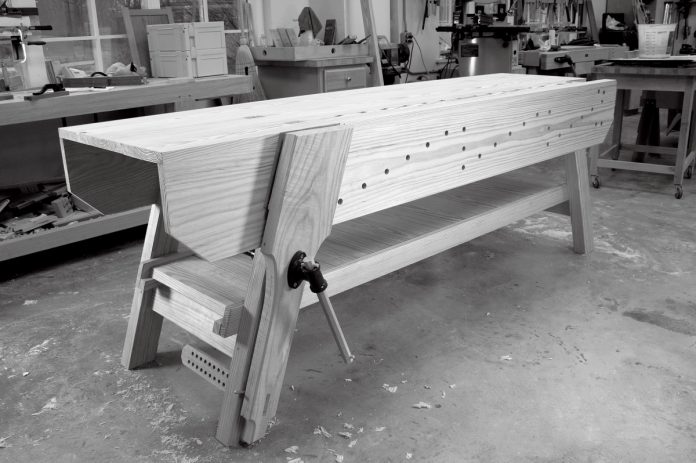We might obtain a fee whenever you use our affiliate hyperlinks. However, this doesn’t influence our suggestions.
This workbench kind is rare in the present day, however it’s nonetheless a sound bench as a result of it lets you carry out all the crucial workbench operations with relative ease. Benches are a triumph of operate over kind.
When it involves constructing or shopping for a bench, most woodworkers get wrapped up in what kind it ought to take. Should it’s a continental bench popularized by Frank Klausz? A Shaker bench just like the one on the Hancock group? How a couple of British model like Ian Kirby’s?
Copying a widely known kind is a pure tack to take. After all, when woodworkers purchase or construct their first workbench, they’re within the early levels of studying the
craft. They don’t know what kind of bench or vises they want, or why one bench seems totally different than one other. So they choose a kind that appears good to them–sometimes mixing and matching bits and items from totally different kinds – and get busy.
That, I consider, is the seed of the problemwith workbenches in the present day. Many industrial workbenches are lacking key capabilities that make work-holding simpler. And many traditional bench kinds get constructed with modifications that make them irritating in use.
What’s worse, the person won’t even know that she or he is struggling. Woodworking is a solitary pursuit, and it’s uncommon to make use of another person’s bench.
During the final 10 years, I’ve constructed quite a few traditional bench kinds, and I’ve labored on craftsman-made and industrial benches of various stripes. I’ve been shocked
by how terrible some workbenches could be at some duties, and I’ve additionally seen brilliantly realized designs.
And now, in any case this work, I’ve concluded that it doesn’t matter what kind of bench you might have so long as it performs a set of core capabilities with ease. I’ve boiled down these core capabilities into 10 guidelines for constructing (or shopping for) a workbench. As lengthy as your bench obeys these guidelines (or most of them), it is possible for you to to carry virtually
any workpiece for any job with a minimum of fuss. This will add velocity and revel inment to your time within the store and cut back the period of time you fuss with setups.
Do You Even Need a Bench?

Spindly workbenches are nothing new. This anemic instance from the early 20th century is simply too small and lacks mass. Sadly, there are fashionable ones which are even worse.
Before we get to the foundations, it’s truthful to say that plenty of the very best industrial woodworking in the present day is completed on benches that disregard many of those guidelines. In manufacturing outlets, it’s uncommon to discover a conventional bench utilized in a conventional method. More typically, a industrial woodworker can have one thing akin to a clamping desk, or perhaps a door on sawhorses. And they will prove high-quality work that may blow you away.
In 2006 I used to be instructing a category in hand work at a faculty the place Thomas Stangeland, a maestro at Greene & Greene-inspired work, was additionally instructing a category. Though we each attempt for a similar end in craftsmanship, the processes we use couldn’t be extra totally different. He builds furnishings for a residing, and he enjoys it. I construct furnishings as a result of I take pleasure in it, and I promote an occasional piece.
One night we every gave a presentation to the scholars about our work and I confirmed a picture of the large French workbench I’d constructed the yr earlier than and mentioned its uncommon historical past.
Thomas then acquired up and stated he wished he had an image of his workbench: a door on a pair horses. He stated {that a} industrial store had no time to waste on constructing a conventional bench. And together with his power-tool strategy, all he wants is a flat floor.It’s laborious to argue with the top end result. His furnishings is gorgeous.
But what’s essential right here is that whilst you can construct with the door-off-the-floor strategy, there are a lot of industrial woodworkers who nonetheless see the utility of a conventional workbench. Chairmaker and furnishings maker Brian Boggs makes use of extra newfangled routers and shop-made gadgets with aluminum extrusions than I’ve ever seen. And he nonetheless has two monumental conventional workbenches that see fixed use. Before Kelly Mehler opened a woodworking faculty, I visited his industrial store and acquired an opportunity to examine his classic bench, which noticed day by day use.
The level is {that a} good bench gained’t make you a greater woodworker, and a
not-quite-a-bench gained’t doom you to failure. But a great bench will make many operations simpler. It’s merely a instrument: the largest clamp within the store.
1. Always Add Mass

This French-style workbench weighs greater than 325 kilos. The prime is 4″ thick. The legs are 5″ sq.. All this mass absorbs vibration and makes each reducing operation smoother.
Always overbuild your workbench by including mass. There is a saying in boatbuilding: If it seems truthful, it’s truthful. For workbenches, right here’s a maxim: If it seems stout, then make it doubly so. Everything a couple of workbench takes punishment that’s akin to a kitchen chair in a home filled with 8-year-old boys.
Early Roman workbenches had been constructed like a Windsor chair. Stout legs had been tenoned into an enormous prime and wedged in place. Traditional French workbenches had huge tops (6″ thick), with legs that had been large enough to be referred to as tree trunks. Later workbenches relied extra on engineering than mass. The traditional continental-style workbench makes use of a trestle design and dovetails within the aprons and vises to create a bench for the ages. The 19th-century English workbench makes use of an early torsion-box design to create a steady place to work. And good-quality fashionable workbenches use threaded rods and bolts to tighten up a design that lacks mass.
Many cheap industrial benches are ridiculously rickety. They sway and rack underneath hand strain. You can push them throughout your store by performing easy operations: routing, sawing, planing. If the bench seems delicate or its elements are sized like a contemporary eating desk, I’d take a better look earlier than committing.
An enormous thick prime and stout legs add mass that may assist your work. Heavy cupboard saws with a number of forged iron are likely to run smoother. The similar goes with benches. Once your bench hits about 300 kilos, it gained’t transfer until you need it to maneuver.
2. Use Stout Joints

Think massive when reducing the joints to your workbench. The small tenons are 1¼” thick and 2½” lengthy. The bigger tenons are 2½” thick and a pair of″ lengthy.
Overbuild your workbench by utilizing the very best joints. These are occasions to whip out the through-tenon and dovetail.
If you adopted rule No. 1, then rule No. 2 must be no downside. Your joints will likely be sized to suit the huge scale of your elements. If you can’t depend on mass, then you need to beef issues up with superior joinery. While dovetails and through-tenons are overkill for a towel rack, they’re good for a bench.
That’s since you are making use of racking power to the workbench with typical operations and your vises will do their greatest to tear aside your bench. All wood vises should be overbuilt or they are going to self-destruct whenever you cinch them down laborious. I’ve even seen a vise rip a benchtop from its base.
Make your tenons thick and your mortises deep. If you understand how to drawbore a mortise-and-tenon joint, that is one good software. Have you ever been in a timber-framed barn? Did you take a look at the joints? They’re huge and pegged. Imitate that.
I believe benches are a great place to follow your abilities at reducing these traditional joints, however some woodworkers nonetheless resist. If that’s you, you need to examine {hardware} to strengthen your bench. Threaded rods, mattress bolts, Veritas bench bolts and even range bolts can flip a spindly meeting into one thing inflexible that may be snugged up if it loosens. The {hardware} wouldn’t offer you mass, however it’ll strengthen a rickety meeting.
3. Pick Your Wood Based on its Stiffness, not its Species

These traditional European workbenches had been made out of fine-grained steamed European beech. Shouldn’t you do the identical? Not essentially. Choose a wooden that’s like beech is in Europe: stiff, cheap and plentiful.
Use a stiff, cheap and customary wooden to construct your bench. Showcase benches made out of unique supplies are good. No argument there. But give attention to the capabilities earlier than the flash. I’d somewhat have a construction-lumber bench that adopted all these guidelines than a phenomenal European beech bench that skipped even one in all
these ideas.
There’s plenty of confusion on selecting a wooden for a bench. Most European benches had been constructed utilizing fine-grained steamed European beech. And many woodworkers go to lengths to buy treasured beech for his or her workbenches. After all, who needs to argue with lots of of years of custom?
I do. European cabinetmakers didn’t select beech due to some magic high quality of Fagus sylvatica. They selected it as a result of it was dense, stiff, plentiful and cheap. In the United States, beech is dense, stiff, laborious to seek out and (typically) a bit spendy. You can, after all, use it to construct a bench, however you’ll pay a reasonably penny for the privilege. And it’ll haven’t any demonstrable benefit over a bench constructed from a less expensive species.
Other woodworkers, tacking towards the smart, use laborious or tender maple for his or her benches, rationalizing that it’s just like the beech of the New World. And certainly, the maples have all of the qualities of a great species for a workbench.
Maple is stiff, resists denting and may span lengthy distances with out a lot of a assist construction beneath it. But so can different species. In truth, in case you glided by the numbers from the wooden technologists alone, you’d construct your bench from shagbark hickory, regardless of its tough nature. Once you take a look at the traits that make a great species for a workbench, you’ll see that white oak, Southern yellow pine, fir or simply about any species (excepting basswood and the tender white pines) will carry out fantastic.
4. Use a Tested Design

Here’s proof that odd workbench designs are noth- ing new. This Hammacher, Schlemmer & Co. bench from an previous catalog is a research in instrument storage. I’ve seen one in all these in individual and I can say this: I gained’t wish to need to construct something utilizing it.
After you sketch out your workbench designal however earlier than you chop any wooden, examine your design with historic designs of benches. If your bench seems to be a radical design or seems not like something constructed earlier than, chances are high your design is flawed.
I’ve seen workbenches with pneumatic face vises. Why? I’ve seen a workbench that had two twin-screw vises: One vise for the appropriate finish of the workbench that was matched to work with two lengthy rows of canine alongside the size of the benchtop; and a second twin-screw vise on the face of the bench that was matched to 2 extra rows of canine throughout the width of the bench.
Now I’m sure that there are just a few woodworkers who would really want this association – maybe somebody who has to work on a round tabletop on one finish of the bench and a Windsor chair seat on the different. But for most individuals who construct cupboards and furnishings, this setup is redundant and neglects some crucial bench capabilities.
5. Overall Dimensions of Your Bench are Critical

Here is how excessive my workbench is in comparison with my hand, which is hanging loosely by my facet. I exploit hand and energy instruments in my work, and I’ve discovered this top is good.
Your bench design can’t be too heavy or too lengthy. But its prime can simply be too vast or too tall. I believe your benchtop must be so long as potential. Find the wall the place your workbench will go (trace: Pick the wall that has a window). Measure that area. Subtract 4 toes from that measurement and that’s a great size for the highest. Note: The benchtop have to be not less than 5′ lengthy until you construct solely small-scale gadgets. Furniture-sized components usually vary as much as 48″ lengthy and also you wish to assist these totally with a little bit room to spare.
I’ve made tops which are 8′ lengthy. My subsequent bench will likely be a 10-footer, the utmost that may slot in my store. It is tough to make or think about a workbench that’s too lengthy. The similar goes for thickness. It is the thickness that permits the highest to be that lengthy. If you make the highest actually thick (4″ or extra), then it’ll provide unerring assist and assist you to construct your bench with none assist system beneath. The prime can perch on the legs and won’t sag underneath its personal weight.
The width is a special matter. You can have a bench that’s too vast for a one- individual store. I’ve labored on benches which are 36″ vast they usually have downsides.
For starters, in case you park them towards the wall you’ll have to stretch to achieve the instruments hanging on the wall. If you assemble initiatives in your bench, one can find your self dancing round it much more than you need to.
But there may be extra. Cabinetwork is sized in commonplace chunks. These sizes come from the human physique; they don’t seem to be arbitrary. A kitchen’s base cupboard is usually 24″ deep and 34½” excessive. This is essential for a pair causes. First: It means you don’t really want a bench that’s rather more than 24″ deep to construct cupboards. With that 24″ depth, you really get some benefits, together with the truth that you may clamp the cupboard to your bench from as many as three sides of your bench.
That is dang helpful. A deep bench lets you clamp your cupboards to the bench on solely two sides (with a pair exceptions). Here’s the opposite factor to bear in mind: Kitchen cupboards are themselves a extremely studied work floor. There’s a great purpose that kitchen cupboards are 24″ deep. And it’s the identical purpose you don’t need your workbench a lot deeper both.
Now I’m not going to argue with you in case you construct actually massive stuff or have a bench that you just share with one other woodworker going through you; you would possibly want extra depth. But if you’re like the remainder of us, a 24″-deep bench is a strong and right-sized instrument.
On the problem of workbench top: Many bench builders fear about it and there are all kinds of guidelines and recommendation. The backside line is the bench should suit you and your work. And ultimately, there are not any hard-and-fast guidelines. I want there have been. Some folks like low benches; some like them excessive.
So take into account the next as a great place to start out. After taking in my crackpot theories, your subsequent cease must be a good friend’s home or a woodworking provide retailer to make use of their benches and get a really feel for what is correct (it may very well be so simple as having a foul again that requires you to have a excessive bench, or a love for wood handplanes that dictates a low bench).
Here is my expertise with bench top: I began with a bench that was 36″ excessive, which appeared proper for somebody who’s 6′ 35⁄8” tall. And for machine woodworking I used to be proper. The excessive bench introduced the work near my eyes. I liked it. And then my ardour for handwork reared its ugly head.
If you get into hand instruments, a excessive bench turns into much less enticing. I began with a jack aircraft and some smoothing planes. They labored OK with a excessive bench, however I turned fatigued shortly.
After studying the screed on bench heights, I lowered the peak of my 36″ bench. It appeared radical, however someday I acquired the nerve up and sawed 2″ off the legs. Those two inches modified my perspective towards planing.
The 34″-bench top allowed me to use my lengthy leg muscle groups to propel the aircraft ahead as a substitute of my arms.
Now, earlier than you construct your subsequent bench at 34″ excessive, cease for a minute. That won’t be best for you. Do you employ wood inventory planes? If so, it’s essential take into account that the wood physique planes can maintain your arms about 3” to 4″ larger off the workbench than a steel aircraft can. As a end result, a wood aircraft person’s workbench must be decrease.
This is nearly as good purpose as ever to get to know somebody who has a great store you may go to and focus on your concepts with. It’s higher to not make this determination on paper alone.
But there are different elements you should take into account when selecting the bench’s top. How tall are you? If you’re over 6′ tall, you need to scale your bench a bit larger. Start excessive and reduce it down if it’s too excessive. And prop it up on some blocks of wooden if it’s too low. Experiment. It isn’t a highboy; it’s a workbench.
Here are different issues to think about: Do you’re employed with equipment? If so, a bench that’s 34″ from the ground – or a bit decrease – could be good. The prime of a desk noticed is often 34″ from the ground, so a workbench may very well be (at most) a fantastic outfeed desk or (not less than) not in the way in which of your crosscutting and ripping.
Of course, everybody needs a ball-park thought for the place to start out. So right here it’s: Stand up straight and drop your arms towards your sides in a relaxed method. Measure from the ground to the place the place your pinky joins your hand. That has been the candy spot for me.
6. Benches Must Hold the Work in Three Ways

This early 20th-century airplane manufacturing unit had the appropriate thought when it got here to workbench size. With an extended bench, you may work on one finish and assemble on the different – no want for an meeting bench. Thus, an enormous bench really saves floorspace.
All benches ought to be capable of grip the wooden so you may simply work on the faces, the ends and the sides. Many industrial benches fail on this level.
Submit your bench to what I name the Kitchen Cabinet Door Test. Imagine a typical kitchen door that’s ¾” thick, 15″ vast and 23″ lengthy. How would you affix that door flat in your bench to stage its joints after which sand (or aircraft) it flat? How would you clamp the door so you might work on the ends to trim the highest rail and tops of the stiles so the door will match its opening? And how will you safe that door on edge so you may rout its hinge mortise and aircraft off the saw-blade marks with out the door flopping round? Does your bench move this check? OK, now ask the identical questions with a door that’s ¾” x 15″ x 38″. And then attempt a board that’s ¾” x 12″ x 6′.
How you accomplish every of those three capabilities is as much as you and your style and price range. To work on the faces of boards, you should use a planing cease, a grippy sanding pad, a tail vise with canine, clamps or hold-downs.
To work on the ends of boards, you may select a shoulder vise (particularly for dovetailing), a steel quick-release vise, a leg vise or a twin-screw vise. And you should use all of those at the side of a clamp throughout your bench. The vise holds one nook of the work; the clamp holds the opposite nook.
Working the lengthy edges of boards is hard with most benches. In truth, most benches make it tough to work the sides of lengthy boards, doorways or face frames. There are a pair methods to unravel this. Older benches had the entrance fringe of the bench-top flush with the entrance of the legs and stretchers so you might clamp your frames and lengthy boards to the legs. And the older benches additionally would have a sliding dead-man (typically referred to as a board jack). It would slide forwards and backwards and had an adjustable peg to assist the work from beneath. Another previous type of bench, an English design, had a large entrance apron that got here down from the highest that was uninterested in holes for a peg to assist lengthy work.
7. Make Your Bench Friendly to Clamps

Most benches are simple to set as much as work on the faces of boards or assemblies. on this instance, a door is clamped between canine. You may even work less complicated and aircraft towards a planing cease.
Your bench is a three-dimensional clamping floor. Anything that interferes with clamping work to your benchtop (aprons, a drawer financial institution, doorways, helps, and many others.) could make some operations a problem.
We had a section at Popular Woodworking the place we tried to design a cupholder into each undertaking. It began innocently with a deck chair. Who doesn’t desire a cool beverage at hand? Then there was the dartboard. What goes higher with darts than beer? I believe we got here to our senses when designing a collection of cupholders right into a Gustav Stickley Morris chair copy. Do you actually need a Big Gulp-sized gap in your Morris chair? I didn’t suppose so.

Working on the ends of boards–particularly vast boards–generally is a problem for face vises. including a clamp to the setup stabilizes the work for sawing or no matter.
The level of this story is as an instance a development in workbench design that I personally discover troubling. It’s a knee-jerk response to a standard American grievance: We don’t suppose we have now sufficient area in our outlets to retailer our instruments and equipment. And how can we remedy this downside with our workbenches? By designing them like kitchen cupboards with a countertop work floor.
This design strategy offers us a number of drawers beneath the benchtop, which is nice for storing the stuff you attain for day by day. It can also make your bench a ache within the hiney to make use of for a lot of widespread operations, reminiscent of clamping issues to your bench.
Filling up the area beneath the bench-top additionally prohibits you from utilizing any kind of holdfast or hold-down that I’m conscious of.

This primitive bench nonetheless lets you work on lengthy edges of boards. The crochet (or hook) grips the board. holdfasts and a scrap assist from beneath. Simple and sensible.
If you construct drawers beneath the highest, how will you clamp objects to the benchtop to work with them? Typically, the banks of drawers beneath the benchtop prohibit a typical F-style clamp from sneaking in there and lending a hand with the setup. So you may’t use a typical clamp to affix a router template to the bench. There are methods round these issues (a tail vise involves thoughts) however the tail vise generally is a problem to put in, set and use.

Here’s one other historic bench that exhibits some difficulties. The drawers will intervene with clamping issues right down to the bench. With no canine or tail vise, this bench may very well be irritating to work on.
You can attempt to cheat (as I’ve) and installthe drawer financial institution so there’s a substantial area beneath the benchtop for hold-fasts and clamps. Or you may give your bench a big overhang to permit clamping (as some Shaker-style workbenches did) however then it’s important to begin engineering a approach to maintain lengthy boards and assemblies on edge.
8. There are Good Rules for Placing Vises on Your Workbench

An oil-varnish mix (any model) is a perfect end for a workbench. It resists stains, doesn’t construct up a movie and is simple to use. Two coats are all I ever use.
Place your vises in order that they work along with your instruments. Vises confuse many workbench builders. They are bewildering when you’ve got by no means spent a lot time working at a bench to develop a style for the peccadilloes of all of the idiosyncratic kinds. There are plenty of bizarre configurations on this planet, from a desk with no vises to the bench with a vise on each nook.
Classic workbenches have some kind of vise on the entrance left nook of the bench. This is named the face vise. Why is it on the left? When we work with hand instruments, particularly planes, right-handers work from proper to left. So having the vise on the left finish of the bench is helpful as a result of you’ll all the time be planing into the vise that’s gripping your work, and the work could be braced towards the screws of the vise. So if you’re a lefty, inserting your vise on the entrance proper nook is smart.
So with that left nook occupied by a vise, the place are you going to place the a second vise that’s designed to grip boards so you may work on their faces? (The traditional vise for this can be a tail vise.) Well the appropriate facet of the bench is free
(for right-handers) and there’s no drawback to inserting it there, so that’s the place it typically goes.
Messing with this association could be bother. I’ve seen face vises on the appropriate nook of the bench of people who find themselves right-handed. They stated they preferred it higher for crosscutting with a handsaw. But when and in case you begin handplaning, that vise will likely be in the way in which as a result of it could not be very best for gripping lengthy inventory. It will likely be holding the tail finish of the board and the aircraft will likely be making an attempt to drag it out of the vise.
9. No Fancy Finishes
When ending a workbench, much less is extra. A shiny movie end permits your work to scoot all around the bench. And a movie end will crack when struck by a hammer or dead-blow mallet. Choose a end that’s simple to use, gives some safety and doesn’t construct up a thick movie. I like an oil/varnish mix (offered as Danish oil), or simply boiled linseed oil.
10. Get a Window Seat

With your workbench towards the wall, you might have the wall and the mass of your bench holding issues regular as you noticed your workpieces. You can also preserve your instruments at arm’s size. And, the home windows solid a helpful gentle in your workbench.
Try to put your bench towards a wall and underneath a window, particularly in case you use hand instruments. The wall braces the workbench as you’re planing cross-grain and sawing. The gentle from the window factors out the failings within the work that your hand instruments try to take away. (When I work with hand instruments, I flip the overhead lights off. I can see significantly better with fewer gentle sources.)
For machine work, I discover that inserting the bench by a window helps with some operations, although not all. When energy sanding, for instance, the raking window gentle factors out scratches higher than overhead fluorescents.
In normal, when working with energy instruments, I have a tendency to drag my workbench away from the wall so I can work on all sides of it. When working with routers, you might need to work with odd clamping setups so as to rout round a template. So accessing all 4 sides of the bench is helpful. Power instrument setups thrive on overhead gentle–and many it. So the window is good, however not as obligatory.
Product Recommendations
Here are some provides and instruments we discover important in our on a regular basis work across the store. We might obtain a fee from gross sales referred by our hyperlinks; nevertheless, we have now rigorously chosen these merchandise for his or her usefulness and high quality.













